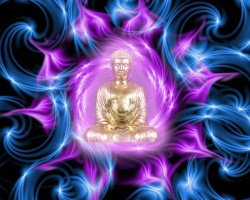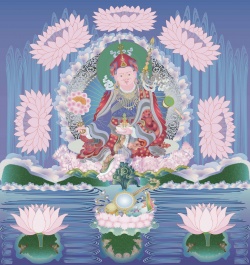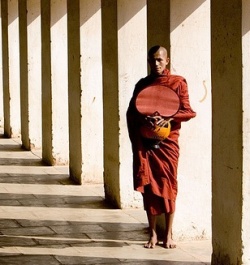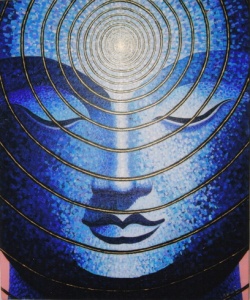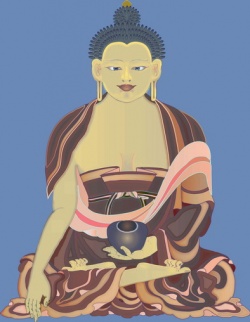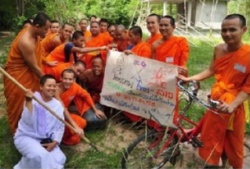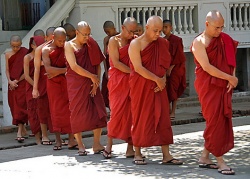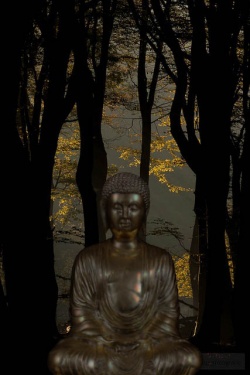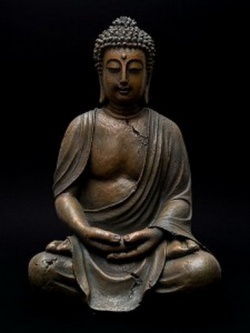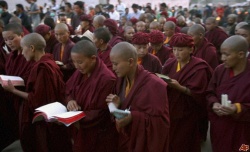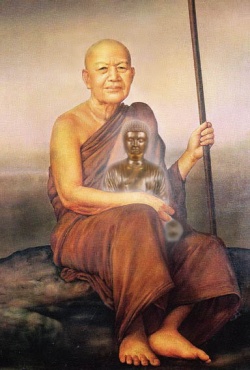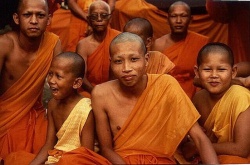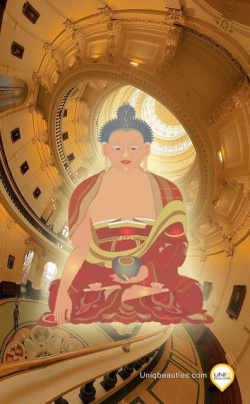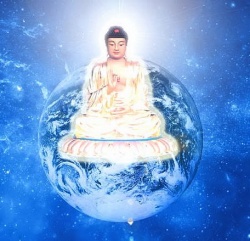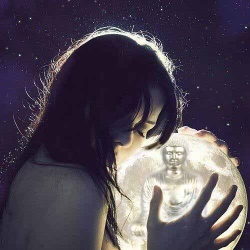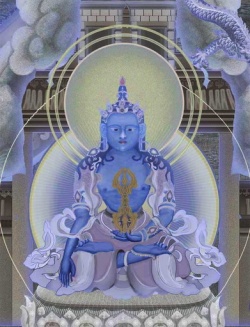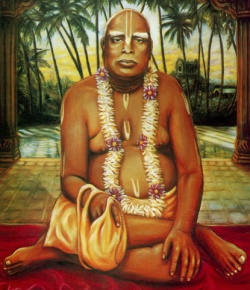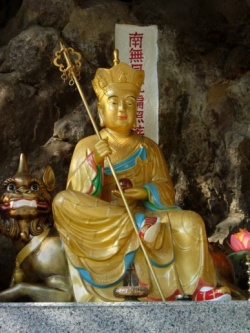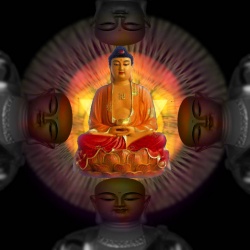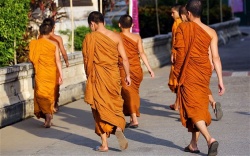Difference between revisions of "Shentong, Yogācāra and Dzogchen"
m (Text replacement - "unmistaken" to "unmistaken") |
m (Text replacement - "]]]" to "]])") |
||
| (One intermediate revision by the same user not shown) | |||
| Line 118: | Line 118: | ||
[[Vimalamitra's]] final paragraph on this passage states: | [[Vimalamitra's]] final paragraph on this passage states: | ||
| − | 'Since neither of those [[exist]] [i.e. [[samsara]] or [[nirvana]] | + | 'Since neither of those [[exist]] [i.e. [[samsara]] or [[nirvana]]), since one [[understands]] that there nothing apart from the originally [[pure]] [[vidyā]] ([[rig pa]]) which apprehends the basis and the [[vidyā]] of [[insight]] which apprehends the chains, it ([[vidyā]]) also does not [[exist]]. Since the [[essence]] of [[vidyā]] does not [[exist]], the [[vidyā]] of the perduring basis (the source of both [[energy]] ([[rtsal]]) and qualities, and also the apprehender of [[characteristics]]) does not [[exist]]. |
Since the [[wisdom]] [[appearances]] of people's own [[vidyā]] that are seen in personal [[experience]] are not established as entities of any kind, it is the [[appearance]] of the exhaustion of [[dharmatā]].' | Since the [[wisdom]] [[appearances]] of people's own [[vidyā]] that are seen in personal [[experience]] are not established as entities of any kind, it is the [[appearance]] of the exhaustion of [[dharmatā]].' | ||
| Line 135: | Line 135: | ||
And: | And: | ||
| − | 'That [[dharmatā]] [[emptiness]] dwells in a fortress and is captured in a fortress: the fortress (that is like a circle of spears in the sky) encircles (without a beginning or an end) [[dharmatā]], i.e., [[existence]] is [[dharmatā]], [[non-existence]] is [[dharmatā]], both are [[dharmatā]] and neither are [[dharmatā]]. As such, | + | 'That [[dharmatā]] [[emptiness]] dwells in a fortress and is captured in a fortress: the fortress (that is like a circle of spears in the sky) encircles (without a beginning or an end) [[dharmatā]], i.e., [[existence]] is [[dharmatā]], [[non-existence]] is [[dharmatā]], both are [[dharmatā]] and neither are [[dharmatā]]. As such, ([[dharmatā]]) is surrounded by the names “clear and unclear”, “[[empty]] and not-empty”, “[[existence]] and [[non-existence]]”, “[[permanence]] and {{Wiki|annihilation}}”, and so on. That lack of finding {{Wiki|evidence}} itself is [[dharmatā]]. Further, in [[reality]] nothing [[exists]] apart from [[dharmatā]]. That being the case, that [[emptiness]] (as a mere [[representation]], baseless, and non-referential, being {{Wiki|non-existent}} like a [[pretense]]) is understood with [[scripture]], accepted by {{Wiki|reasoning}}, proven by argument, and captured in a fortress. Be confident that [[dharmatā]] is the unmistaken true [[emptiness]].' |
Therefore, to describe [[Dzogchen]] as an [[affirming]] {{Wiki|negation}} does not make any [[sense]] at all. | Therefore, to describe [[Dzogchen]] as an [[affirming]] {{Wiki|negation}} does not make any [[sense]] at all. | ||
| Line 141: | Line 141: | ||
[Sorry, I made a translation error -- this is from an old, unedited translation I have not re-examined. The passage should be read: | [Sorry, I made a translation error -- this is from an old, unedited translation I have not re-examined. The passage should be read: | ||
| − | "Since neither of those [[exist]] [i.e. [[samsara]] or [[nirvana]] | + | "Since neither of those [[exist]] [i.e. [[samsara]] or [[nirvana]]), one [[understands]] that the originally [[pure]] [[vidyā]] ([[rig pa]]) which apprehends the basis and the [[vidyā]] of [[insight]], the chains, do not [[exist]] other than being mere designations..." |
(My bad I don't usually trot out unedited translations without checking them to see if they are free of errors) | (My bad I don't usually trot out unedited translations without checking them to see if they are free of errors) | ||
| Line 153: | Line 153: | ||
Equally controversially, [[Dolpopa]] was not afraid to employ the term '[[Self]]' or '[[Soul]]' ([[atman]]) to refer to the [[Wikipedia:Absolute (philosophy)|ultimate]] [[Buddhic]] [[Truth]] that according to him lay at the [[heart]] of all being. In his [[Mountain Doctrine]] work, he refers to this [[Buddhic]] [[Essence]] as the 'Great [[Self]]', '[[True Self]]', '[[Diamond]] [[Self]]', 'Supreme [[Self]]', 'Solid [[Self]]', and 'Supreme [[Self]] of all Creatures', basing himself on specific utterances and [[doctrines]] of the [[Buddha]] in the [[Mahayana Mahaparinirvana Sutra]], the [[Angulimaliya Sutra]], and [[Srimala Sutra]], amongst others (see Hopkins, Jeffrey, [[Mountain Doctrine]], 2006 passim). While most [[Buddhists]] baulk at such a term, there are still exponents of the [[Nyingma]] and [[Kagyu traditions]] of [[Buddhism]] (as well as [[Dolpopa's]] own [[Jonangpa School]]) who are [[happy]] to see the [[heart]] of all [[beings]] as one unified, [[egoless]] [[Buddha-Self]]. Contemporary {{Wiki|Oxford University}} Doctor of [[Buddhist philosophy]] and [[Tibetan]] [[Kagyu]] [[lama]], [[Shenpen Hookham]], for example, writes affirmatively of the [[True Self]] in the teachings of [[Dolpopa]] and other great [[Buddhist masters]], saying: | Equally controversially, [[Dolpopa]] was not afraid to employ the term '[[Self]]' or '[[Soul]]' ([[atman]]) to refer to the [[Wikipedia:Absolute (philosophy)|ultimate]] [[Buddhic]] [[Truth]] that according to him lay at the [[heart]] of all being. In his [[Mountain Doctrine]] work, he refers to this [[Buddhic]] [[Essence]] as the 'Great [[Self]]', '[[True Self]]', '[[Diamond]] [[Self]]', 'Supreme [[Self]]', 'Solid [[Self]]', and 'Supreme [[Self]] of all Creatures', basing himself on specific utterances and [[doctrines]] of the [[Buddha]] in the [[Mahayana Mahaparinirvana Sutra]], the [[Angulimaliya Sutra]], and [[Srimala Sutra]], amongst others (see Hopkins, Jeffrey, [[Mountain Doctrine]], 2006 passim). While most [[Buddhists]] baulk at such a term, there are still exponents of the [[Nyingma]] and [[Kagyu traditions]] of [[Buddhism]] (as well as [[Dolpopa's]] own [[Jonangpa School]]) who are [[happy]] to see the [[heart]] of all [[beings]] as one unified, [[egoless]] [[Buddha-Self]]. Contemporary {{Wiki|Oxford University}} Doctor of [[Buddhist philosophy]] and [[Tibetan]] [[Kagyu]] [[lama]], [[Shenpen Hookham]], for example, writes affirmatively of the [[True Self]] in the teachings of [[Dolpopa]] and other great [[Buddhist masters]], saying: | ||
| − | [[Absolute]], [[Eternal]] [[True Self]]: Many [[venerable]] [[saints]] and [[scholars]] have argued for the [[Self]] in the {{Wiki|past}} and do so in the {{Wiki|present}}. Great [[teachers]] of the [[Tibetan]] [[Nyingma]], [[Kagyu]] and [[Sakya]] schools have and do argue that such a [[view]] [i.e. the [[reality]] of an [[essential]], {{Wiki|deathless}} [[Self]] | + | [[Absolute]], [[Eternal]] [[True Self]]: Many [[venerable]] [[saints]] and [[scholars]] have argued for the [[Self]] in the {{Wiki|past}} and do so in the {{Wiki|present}}. Great [[teachers]] of the [[Tibetan]] [[Nyingma]], [[Kagyu]] and [[Sakya]] schools have and do argue that such a [[view]] [i.e. the [[reality]] of an [[essential]], {{Wiki|deathless}} [[Self]]) is fundamental to the practice of the [[Buddhist path]] and the [[attainment]] of [[Enlightenment]]. |
Hookham further points out in her study of [[Dolpopa's]] [[form]] of [[Shentong]] teachings that [[Dolpopa]] (along with other representatives of this [[Shentong]] [[tradition]], including such [[Tibetan]] [[Shentong]] [[masters]] as [[Rangjung Dorje]], [[Mikyo Dorje]] and [[Jamgon Kongtrul]]) really envisioned the [[Buddha]] within each being as an actual, living [[truth]] and presence, not [[conditioned]] or generated by any {{Wiki|temporal}} process of [[causation]]: | Hookham further points out in her study of [[Dolpopa's]] [[form]] of [[Shentong]] teachings that [[Dolpopa]] (along with other representatives of this [[Shentong]] [[tradition]], including such [[Tibetan]] [[Shentong]] [[masters]] as [[Rangjung Dorje]], [[Mikyo Dorje]] and [[Jamgon Kongtrul]]) really envisioned the [[Buddha]] within each being as an actual, living [[truth]] and presence, not [[conditioned]] or generated by any {{Wiki|temporal}} process of [[causation]]: | ||
| − | The [[essential]] feature of a [[Shentong]] interpretation of [[tathāgatagarbha doctrine]] is that the [[Buddha]] is literally within all [[beings]] as their [[unchanging]], [[permanent]], non-conditioned [[nature]] .... [[Buddha]] is by all [tathāgatagarbha-sutra] accounts considered to be non-conditioned, [[eternal]], [[unchanging]], [[bliss]], [[compassion]], [[wisdom]], power, and so on. For [[Shentongpas]] [i.e. the {{Wiki|adherents}} of a [[Shentong]] [[understanding]] of [[scripture]] | + | The [[essential]] feature of a [[Shentong]] interpretation of [[tathāgatagarbha doctrine]] is that the [[Buddha]] is literally within all [[beings]] as their [[unchanging]], [[permanent]], non-conditioned [[nature]] .... [[Buddha]] is by all [tathāgatagarbha-sutra] accounts considered to be non-conditioned, [[eternal]], [[unchanging]], [[bliss]], [[compassion]], [[wisdom]], power, and so on. For [[Shentongpas]] [i.e. the {{Wiki|adherents}} of a [[Shentong]] [[understanding]] of [[scripture]]) the fact that [[Buddha]] is non-conditioned means the [[essence of Buddha]] is complete with all the [[Buddha]] Qualities in a timeless [[sense]]'. |
[[Dolpopa]] uses many [[scriptural]] citations to support his [[view]], drawing upon [[sutras]] and [[tantras]] to substantiate his [[understanding]] of [[Mahayana]] and [[tantric teachings]] on definitive [[truth]]. As Cyrus Stearns writes in his {{Wiki|monograph}} on [[Dolpopa]], this scholar-monk made: | [[Dolpopa]] uses many [[scriptural]] citations to support his [[view]], drawing upon [[sutras]] and [[tantras]] to substantiate his [[understanding]] of [[Mahayana]] and [[tantric teachings]] on definitive [[truth]]. As Cyrus Stearns writes in his {{Wiki|monograph}} on [[Dolpopa]], this scholar-monk made: | ||
| Line 169: | Line 169: | ||
This felicitous state is said to lie within the being, eternally. But within the [[samsaric]] mode of perceiving, it is not recognised, and {{Wiki|darkness}} remains. Stearns brings out the {{Wiki|distinction}} which [[Dolpopa]] draws here between [[samsara]] and [[Nirvana]], quoting [[Kalkin]] [[Pundarika]] to make the point: | This felicitous state is said to lie within the being, eternally. But within the [[samsaric]] mode of perceiving, it is not recognised, and {{Wiki|darkness}} remains. Stearns brings out the {{Wiki|distinction}} which [[Dolpopa]] draws here between [[samsara]] and [[Nirvana]], quoting [[Kalkin]] [[Pundarika]] to make the point: | ||
| − | + | ([[Samsaric]]) [[existence]] and [[nirvana]] are not [[identical]], but like a shadow and the {{Wiki|sun}}. | |
For [[Dolpopa]], the indwelling [[Buddha]] (or [[Nirvana]]) is genuinely real, yet '[[empty]]' in one [[sense]] - in that the internal [[Buddha]] or [[Buddha nature]] is [[empty]] of [[illusion]], but replete with wondrous [[Buddha]] qualities. For [[Dolpopa]] and those who espouse analogous [[Shentong]] [[doctrines]]: | For [[Dolpopa]], the indwelling [[Buddha]] (or [[Nirvana]]) is genuinely real, yet '[[empty]]' in one [[sense]] - in that the internal [[Buddha]] or [[Buddha nature]] is [[empty]] of [[illusion]], but replete with wondrous [[Buddha]] qualities. For [[Dolpopa]] and those who espouse analogous [[Shentong]] [[doctrines]]: | ||
| Line 277: | Line 277: | ||
{{R}} | {{R}} | ||
[http://dharmaconnectiongroup.blogspot.com.au/2013/07/shentong-yogacara-and-dzogchen.html dharmaconnectiongroup.blogspot.com.au] | [http://dharmaconnectiongroup.blogspot.com.au/2013/07/shentong-yogacara-and-dzogchen.html dharmaconnectiongroup.blogspot.com.au] | ||
| − | [[Category:Shentong[[File:|thumb|250px|]] | + | [[Category:Shentong[[File:|thumb|250px|]])] |
Latest revision as of 18:43, 4 April 2016
Shentong, Zhantong and gzhan stong are synonymous: Shentong (also, zhäntong or zhentong; Tibetan: གཞན་སྟོང་, Wylie: gzhan stong, Lhasa dialect IPA: [ɕɛ̃̀tṍŋ]; English pronunciation: shen-tong), is literally "other-emptiness", i.e., emptiness of other.]
Jackson Peterson:
Interesting and brief explanation of the "shentong" or "zhantong" teaching of "other emptiness" also known as the Great Madhyamaka:
Kyle Dixon: The fact that Shentong, a view which directly contradicts Madhyamaka, has a title like 'Great Madhyamaka' attributed to it is incredibly bizarre. Although apparently it's not a moniker which is exclusive to Shentong...
Great Mādhyamaka: a qualification and disambiguation
Pettit (1999: p. 113) qualifies and disambiguates "Great Mādhyamaka" and mentions Ju Mipham, Longchenpa, Prasaṅgika Mādhyamaka, Tsongkhapa and coalescence:
Extrinsic emptiness Shentong is also referred to as "Great Mādhyamaka" (dbu ma chen po), a term that appears frequently in Mipham's works. This term can also be misleading, because dbu ma chen po does not refer exclusively to extrinsic emptiness. Klong chen pa and Mipham use it to refer to Prasaṅgika Mādhyamaka, because it emphasizes the nonconceptual ultimate, which they understand as the principle of coalescence. Tsongkhapa also uses this term in passing, for example, in the colophon of his dBu-ma dgongs-pa rab-gsal.[2]
Jackson Peterson: Wrong Kyle Dixon, Zhantong does not in any way contradict rangtong view. Read Lama Tony's excellent translations on the topic and become educated on the topic. The view of Zhantong is breath taking and unassailable, which can be seen easily when you read their rhetoric arguments refuting the "Gelugpa" view regarding Zhantong.
Jackson Peterson: http://www.tibet.dk/pktc/transpaper.htm#LionsRoarofZhantong
PKTC - Books and Translations
www.tibet.dk
The committee actively pursues textual translations. A number of translations are available in paper.
Kyle Dixon: Depends on the presentation. Not my cup of tea either way but if one isn't careful Shentong can become a guise for svabhāva and may result in extreme views (eternalism). It's considered by many to be synonymous with traditions like Advaita Vedanta.
Jackson Peterson: Yes, many speak ignorantly about Zhantong, that's true. But the greater risk as Nagarjuna stated is becoming biased by "emptiness" teachings (rangtong) that may lead to nihilism. The consequences of nihilism are much worse, hence the Buddha turned the "Wheel" a third time...
Tyler Jones: I always wondered why some Dzogchenpas are so critical of Shentong when as great a master as Jamgon Kongtrul was a Shentongpa.
Jackson Peterson: Tyler Jones, yes indeed.., Dudjum Rinpoche, Kalu Rinpoche, Dilgo Khentse , Ju Mipham, and many more supported the view. Its closer to Dzogchen then rangtong alone.
Greg Goode: The consequences of nihilism are much worse. But which is more common, nihilism or an essentialistic svabhāva view? Among the cybercitizens who I've observed talk about these things, I've seen both extremes.
They go together actually. A nihilist is a frustrated essentialist.
Most nihilists have an essentialist, svabhāva-based criterion of existence. What they require for existence turns out to entail some independent, self-established, inherent status. The standard is impossibly high. And so they feel that most everything fails to come up to that standard. And so nonexistence ends up getting more weight with them.
Quite often, an essentialist is a haunted nihilist.
The foundationalist-type nihilist will often feel that without a guaranteed, inherent existence somewhere, everything will lead to chaos and doom. This must not be allowed to happen. To avoid this haunting, they'll land on at least something self-standing, which can serve as the basis for everything else.
Kyle Dixon: Tyler, dzogchenpas are critical of Shentong because it's an eternalistic view and therefore heretical in dzogchen's eyes. It may have it's place and advantages in context but as a view in and of itself it is essentialist in nature.
Kyle Dixon: I wouldn't say it's closer to dzogchen at all, if anything dzogchen would propose a happy medium. But Mipham for example argued for and against Shentong so he was not solely an advocate. Dudjom Rinpoche said that Shentong is a useful view when one is practicing however in a debate setting or when describing the dzogchen view one should implement rangtong. Overall though most of the key figures in dzogchen say that early Indian Prasaṅgika is the definitive view. So where you get that Shentong is closer to dzogchen I'm not sure, that is not what I see... and I would say that is an inaccurate and misleading assertion.
Jackson Peterson: Kyle Dixon, nothing is eternalistic about Zhantong. You don't understand the view. Dzogchen postulates a rigpa which is saying "something" or affirming a rigpa as Buddha Nature or Natural State. Prasangika by definition can't go there.
Kyle Dixon: Vidyā is 100% empty and completely unestablished in any way whatsoever, so no it's not saying 'something' apart from the convention that is vidyā. No vidyā is 'affirmed' (or denied) because vidyā is empty. Buddha nature is one's potential for buddhahood, it's important not to take a literal view of Buddha nature and turn it into a self. Samantabhadra even says that Buddha nature is a tentative description used to instill confidence in the immature who are eaten by doubt. Prasaṅgika has never had any need to discuss the 'unconditioned' phenomena of vidyā ergo you can look at the dzogchen model as an extension of the Prasaṅgika model. Even at that, all of these things are completely empty, the basis (gzhi) etc., are conventions. A freedom from extremes is always upheld.
May 1 at 10:30am via mobile · Edited · Like
Kyle Dixon: But I will give you the benefit of the doubt and take your advice that my perception of Shentong may be limited or misinformed... and will read the few books Duff has published. I have them but haven't read them yet.
Tyler Jones: Some, like Mipham Rinpoche and Dudjom Rinpoche, taught both Shentong and Rangtong in different circumstances. Others, like Jamgon Kongtrul and Kalu Rinpoche, were avowed Shentongpas. I would personally be very hesitant to call such masters heretics.
Kyle Dixon: Ah I said that the view 'in and of itself' meaning the view standing alone would be considered heretical. I never once asserted, or even entertained the thought, that Jamgon Kongtrul, Kalu Rinpoche, Dudjom Rinpoche, Mipham or any other great masters were heretics, homage and praise to all of them.
I did mention that about Mipham and Dudjom Rinpoche if you read my post above, Mipham did attempt to venture out in the name of non-sectarianism and bridge the dzogchen view with others. Many believe he wasn't successful and may have only succeeded in creating a denaturation of the dzogchen view. I've seen Yogācāra proponents attempt to argue that Dzogchen and Yogācāra are equivalent, their entire premise based on Mipham's works.
Tyler Jones: I just get the impression that if Kongtrul had a time machine and knew English, and came and posted about his view in this group under an alias, you would accuse him of heresy, being no different from Advaita, not understanding Nagarjuna, etc etc. But that's just fantasy I guess.
Tyler Jones: As far as Yogacara goes, why it gets so much flack in Tibetan circles is also something I have never understood. That Mipham revived the Yogacara-Madhyamaka system employed by the original Nyingma masters seemes like a great thing to me. The 3rd Karmapa also taught a synthesis of Yogacara and Madhyamaka. How do you propose this denaturates Dzogchen?
Kyle Dixon: No one's being accused of heresy here, I don't seem to be making that clear I guess. I'm saying Shentong, as a view, is eternalistic in nature and therefore a tradition like dzogchen would consider it heretical, since dzogchen does not champion eternalism (nor nihilism). I'm not saying Shentong is indeed heretical, I'm saying from the perspective of dzogchen, if Shentong was proposed as an 'end all and be all indisputable truth' would be considered a heretical claim. That isn't to say any individuals are heretics, that isn't to say anyone here is a heretic, that isn't even to say that Shentong actually is heretical, I'm only noting that Shentong proposes an extreme, and another view which upholds a freedom from extremes, would disagree with Shentong's view... but Shentongpas may disagree with them, it's all point of view. I will say that traditional Madhyamaka does make an effort to stray from extremes though and does not actually propound a 'view', not even 'no view'.
Jackson Peterson: Read Tony's translations...Kyle Dixon, I think that will be useful in making better sense of this all. But if Dzogchen didn't affirm a "rigpa" or Natural State as the topic in a "Direct Introduction" to rigpa, then I am at a complete loss at how you can state the most important aspect of Dzogchen, the "direct intoduction", doesn't clearly affirm the presence of rigpa, "the self-recognizing knowingness". That my friend is an affirmation if I ever heard of one, hence I insist based on that fact alone that Dzogchen's dialectic is an "affirming negation". Rigpa is as it's emptiness a negation of 4 way inherency, but as its luminosity is discussed and affirmed in the introduction to ripga, it has gone outside the bounds of Prasangika's "not offering a position of its own" beyond the negations. Isn't that clear??
May 1 at 11:33am · Like
Tyler Jones: Kyle, thanks for clarifying. That seems entirely agreeable to me.
Jackson Peterson: Kyle Dixon's confusion is based on the misunderstanding that "Zhantong" view is "eternalistic". Please Kyle, share one Zhantong text quote that proves that contention...just one please at least...
Kyle Dixon: Tyler, It would denaturate dzogchen for a few reasons, (i) Yogācāra upholds that mind (consciousness) is truly accomplished and is inherently existent, Yogācāra therefore falls victim to an extreme view. Dzogchen would vehemently disagree with that position. (ii) Yogācāra upholds that phenomena are subsumed into consciousness, as expressions of consciousness, dzogchen would disagree.
For example Jigme Lingpa states in his Yönten Dzö:
"Furthermore the objective basis of perception is not mind.
Though the reflected image of a face is contained in a mirror,
it is merely due to conditions that arise through dependent origination;
Face and mirror are never found to me mixed together."
And here he objects to the notion of a truly established mind or consciousness (even reflexively):
"There is another aspect of the Yogācāra doctrine, related to the mind-only doctrine, that is criticized in Yeshe Lama and elsewhere in Jigme Lingpa's work: the concepts of reflexive awareness (rang rig) and reflexive luminosity (rang gsal). These terms near-synonyms, are fundamental of the Yogācāra understanding of the way the mind works. They refer to the activity of a mind that does not cognize phenomena as extrinsic: it is cognizant only of itself, and, like a lamp that needs no other light source to be visible, it illuminates itself. Both terms were utilized in this way by Śāntarakṣita in his eighth-century works setting out the Yogācāra Svātantrika Madhyamaka position.
Jigme Lingpa writes in Yeshe Lama, 'If...when you examine that which abides, the mere reflexive luminosity (rang gsal) of the ālāyavijñāna comes up as truly accomplished, then you approach the mistake of the Anākāravāda mind-only doctrine.' We have seen above how the Sākāravāda form of Yogācāra is criticized by Longchenpa and Jigme Lingpa, based on the distinction between mere perceptions and the objective basis for perceptions. The Anākāravāda form of Yogācāra, which did not accept the ultimate reality of consciousness as the objective basis for perceptions, is criticized for a different reason. In his Khyenste Melong, Jigme Lingpa sets out what he understands the Anākāravāda position to be:
'We hold that the outer object does not exist, and the awareness that apprehends it does not exist either. The awareness that realizes the apprehender and apprehended as nondual is a reflexive awareness and a reflexive luminosity. This is designated as truly existent. This is the ālāya-vijñāna. Actions and their result are based on it.'
The Anākāravāda position is criticized for attributing reflexive awareness with true existence. The terms reflexive awareness and reflexive luminosity are often used in the Great Perfection, and figure frequently in the Longchen Nyingtig texts themselves. Jigme Lingpa cannot criticize the use of the terms themselves. He must object to the designation of them being truly established, that is, existent. As the passage from Khyenste Melong suggests, this is also a criticism of the position that holds the ālāya-vijñāna, the basis of consciousness, as the basis of both samsaric and nirvanic awareness. For Jigme Lingpa, and his Seminal Heart sources, the ālāya-vijñāna is samsaric in nature, a result of delusion and separation from the ground, as I have shown in chapter 4. Thus these criticisms of the Yogācāra are rooted in the Seminal Heart distinction between two types of basis, the nirvanic basis known as the ground (gzhi) and the samsaric basis of consciousness, the ālaya (kun gzhi). Because the distinction is not made in the Indian Yogācāra texts, the versions of reflexive awareness and reflexive luminosity found there are considered flawed. Yet the Seminal Heart owed a great debt to Yogācāra philosophy in it's treatments of both samsaric and nirvanic awareness, and this is why Jigme Lingpa, like Longchenpa before him, felt the need to strongly distinguish the differences between the models of awareness in Yogācāra and Seminal Heart literature."
- Sam Van Shaik
Kyle Dixon: Jackson, again regarding your affirming negation theory:
Malcolm wrote:
Well for example, your notion that Dzogchen is an affirming negation turns out to be completely unsupported by the primary texts of the system. But that does not require debate, that merely requires reading the texts themselves.
In general, we find that in many Dzogchen texts the twin terms dgag and sgrub are used -- dgag means to refute, sgrub means to prove. The essence of debate is refutation and proof, rejecting one point of view and accepting another point of view. But in reality, as Rongzom Chozang points out, the state of Dzogchen is beyond both refutation and proof. This is why I continue to insist that it is waste of time to debate about Dzogchen
Jax wrote:
You are Being.
Malcolm wrote:
This is not Dzogchen. This is Neo-Advaita.
Jax wrote:
Ok... you are not Being? If Dzogchen is a 'confirming negation', which it is, then there is affirmative existence regarding Rigpa. This is the difference between Madhyamaka and Dzogchen. Madhyamaka is a 'non-confirming negation', leaving us just with emptiness. Hence Madhyamaka is a different result. Vajrasattva means Diamond Being. It is not about neo-advaita or Taoism... its about what we are. We are Aware Emptiness in full integration with our equally empty, yet appearing Luminosity.
Malcolm wrote:
What makes you think Dzogchen is a affirming negation?
This is not the case. Dzogchen does not have a view to support or promulgate, and that is what affirming negations are for i.e. rejecting one thing in order to prove one's own perspective. By asserting that Dzogchen is asserting an affirming negation you are rendering Dzogchen inferior to Madhyamaka.
If Dzogchen is an affirming negation, than this statement from the Unwritten Tantra makes no sense:
'Apparent yet non-existent retinue, listen well! There is no object to distinguish in me, the view of self-originated wisdom; it did not exist before, it will not arise later, and also does not appear in anyway in the present. The path does not exist, action does not exist, traces do not exist, ignorance does not exist, thoughts do not exist, mind does not exist, prajñā does not exist, samsara does not exist, nirvana does not exist, vidyā itself does not even exist, totally not appearing in anyway.'
Vimalamitra's final paragraph on this passage states:
'Since neither of those exist [i.e. samsara or nirvana), since one understands that there nothing apart from the originally pure vidyā (rig pa) which apprehends the basis and the vidyā of insight which apprehends the chains, it (vidyā) also does not exist. Since the essence of vidyā does not exist, the vidyā of the perduring basis (the source of both energy (rtsal) and qualities, and also the apprehender of characteristics) does not exist.
Since the wisdom appearances of people's own vidyā that are seen in personal experience are not established as entities of any kind, it is the appearance of the exhaustion of dharmatā.'
Further, Vimalamitra states in The Lamp Summarizing Emptiness:
'Now then, the emptiness of dharmatā: natural dharmatā is the emptiness of the non-existence of a primal substance. Thus, all appearances were never established according to the eight examples of illusion. When appearances spread, that basis of the emptiness of dharmatā does not shift whatsoever, never transcending the emptiness of dharmatā. Furthermore:
Everything arose from non-arising;
even arising itself never arose.
Dharmatā in and of itself is empty without a basis, present at all times as the single nature of the great emptiness of the basis, path, and result. Furthermore, primordial emptiness is empty without beginning. [180]
Empty things are empty by nature.
Since the emptiness of dharmatā is present without being contrived and without being transformed in the basis, yogins are also liberated by remaining naturally without contrivance and without transformations.'
And:
'That dharmatā emptiness dwells in a fortress and is captured in a fortress: the fortress (that is like a circle of spears in the sky) encircles (without a beginning or an end) dharmatā, i.e., existence is dharmatā, non-existence is dharmatā, both are dharmatā and neither are dharmatā. As such, (dharmatā) is surrounded by the names “clear and unclear”, “empty and not-empty”, “existence and non-existence”, “permanence and annihilation”, and so on. That lack of finding evidence itself is dharmatā. Further, in reality nothing exists apart from dharmatā. That being the case, that emptiness (as a mere representation, baseless, and non-referential, being non-existent like a pretense) is understood with scripture, accepted by reasoning, proven by argument, and captured in a fortress. Be confident that dharmatā is the unmistaken true emptiness.'
Therefore, to describe Dzogchen as an affirming negation does not make any sense at all.
[Sorry, I made a translation error -- this is from an old, unedited translation I have not re-examined. The passage should be read:
"Since neither of those exist [i.e. samsara or nirvana), one understands that the originally pure vidyā (rig pa) which apprehends the basis and the vidyā of insight, the chains, do not exist other than being mere designations..."
(My bad I don't usually trot out unedited translations without checking them to see if they are free of errors)
The passage is trying to state that all of these discussions are merely nominal. This is why Longchenpa, Jigme Lingpa and others state over and over the intention of Dzogchen and the intention of Madhyamaka are the same.]
Kyle Dixon: Jackson, doesn't get anymore eternalistic than Dolpopa Sherab Gyaltsen, the very man who was responsible for the inception of Shentong:
The entire corpus of Dolpopa's writings was completely suppressed by the dominant Gelukpa order for several hundred years, although it is sometimes claimed that this suppression was equally for political reasons as doctrinal. The reasons for this include his controversial definition of the Buddhist concept of śūnyatā (usually translated as "emptiness" or "voidness") as being twofold, including both "emptiness of self-nature" and "emptiness of other (shentong)". He taught that emptiness of self-nature applied only to relative truth, while emptiness of other is characteristic of ultimate truth, i.e. ultimate Reality is not empty of its own uncreated and deathless Truth - the Eternal Buddha -, but only of what is impermanent and illusory - see Hopkins, Mountain Doctrine, 2006, passim).
Equally controversially, Dolpopa was not afraid to employ the term 'Self' or 'Soul' (atman) to refer to the ultimate Buddhic Truth that according to him lay at the heart of all being. In his Mountain Doctrine work, he refers to this Buddhic Essence as the 'Great Self', 'True Self', 'Diamond Self', 'Supreme Self', 'Solid Self', and 'Supreme Self of all Creatures', basing himself on specific utterances and doctrines of the Buddha in the Mahayana Mahaparinirvana Sutra, the Angulimaliya Sutra, and Srimala Sutra, amongst others (see Hopkins, Jeffrey, Mountain Doctrine, 2006 passim). While most Buddhists baulk at such a term, there are still exponents of the Nyingma and Kagyu traditions of Buddhism (as well as Dolpopa's own Jonangpa School) who are happy to see the heart of all beings as one unified, egoless Buddha-Self. Contemporary Oxford University Doctor of Buddhist philosophy and Tibetan Kagyu lama, Shenpen Hookham, for example, writes affirmatively of the True Self in the teachings of Dolpopa and other great Buddhist masters, saying:
Absolute, Eternal True Self: Many venerable saints and scholars have argued for the Self in the past and do so in the present. Great teachers of the Tibetan Nyingma, Kagyu and Sakya schools have and do argue that such a view [i.e. the reality of an essential, deathless Self) is fundamental to the practice of the Buddhist path and the attainment of Enlightenment.
Hookham further points out in her study of Dolpopa's form of Shentong teachings that Dolpopa (along with other representatives of this Shentong tradition, including such Tibetan Shentong masters as Rangjung Dorje, Mikyo Dorje and Jamgon Kongtrul) really envisioned the Buddha within each being as an actual, living truth and presence, not conditioned or generated by any temporal process of causation:
The essential feature of a Shentong interpretation of tathāgatagarbha doctrine is that the Buddha is literally within all beings as their unchanging, permanent, non-conditioned nature .... Buddha is by all [tathāgatagarbha-sutra] accounts considered to be non-conditioned, eternal, unchanging, bliss, compassion, wisdom, power, and so on. For Shentongpas [i.e. the adherents of a Shentong understanding of scripture) the fact that Buddha is non-conditioned means the essence of Buddha is complete with all the Buddha Qualities in a timeless sense'.
Dolpopa uses many scriptural citations to support his view, drawing upon sutras and tantras to substantiate his understanding of Mahayana and tantric teachings on definitive truth. As Cyrus Stearns writes in his monograph on Dolpopa, this scholar-monk made:
... the assertion that ultimate truth, referred to by terms such as tathāgatagarbha (Buddha-nature), dharmadhātu (expanse of reality), and dharmakāya (buddha-body of reality), is a permanent or eternal state. Of course, statements to this effect are not unusual in certain Mahayana sutras and treatises ....For Dolpopa, all such statements in the scriptures and commentaries were of definitive meaning (nītārtha, nges don), and were to be understood literally.
Dolpopa also frequently makes use of such positive terms which he finds in the selfsame scriptures and tantras as 'permanent', 'everlasting, 'eternal' and 'Self' (Stearns, ibid.). This, Dolpopa claims, all pertains to the realm of Nirvana, and is one with the Buddha-nature. It is not merely an intellectual view, but a direct experience of great bliss, and this doctrine is (according to Dolpopa) communicated to Buddhists via the mediacy of the Mahayana Buddha-nature sutras:
The ultimate Mahayana is the vehicle of the Buddha-nature, and the ultimate Buddha-nature is great bliss.
This felicitous state is said to lie within the being, eternally. But within the samsaric mode of perceiving, it is not recognised, and darkness remains. Stearns brings out the distinction which Dolpopa draws here between samsara and Nirvana, quoting Kalkin Pundarika to make the point:
(Samsaric) existence and nirvana are not identical, but like a shadow and the sun.
For Dolpopa, the indwelling Buddha (or Nirvana) is genuinely real, yet 'empty' in one sense - in that the internal Buddha or Buddha nature is empty of illusion, but replete with wondrous Buddha qualities. For Dolpopa and those who espouse analogous Shentong doctrines:
... the whole point of establishing the empty nature of illusion (rangtong) is to discover the Reality of the Absolute Buddha Wisdom Mind (Paramarthabuddhajnana) beyond the reaches of the conceptual mind that can only function in terms of grasping its own creations.
Dolpopa further comments that worldlings believe that they have Self, happiness, permanence and purity, but that they look in the wrong direction for these transcendental qualities, whereas those who have transcended the world use these terms meaningfully, since they know where these qualities are to be found. Even having faith in the reality of these higher qualities helps remove spiritual veils. Hookham writes:
'Dolpopa explains that the worldling believes he has self, permanence, bliss, and purity; he sees these qualities in what does not have them. Those who are beyond the world also talk of Self, Permanence, Bliss, and Purity, but in their case it is meaningful, because they know what really has these qualities. Dolpopa remarks that just to believe this removes many veils, thus emphasising the power of faith' Cyrus Stearns points out that for Dolpopa, spiritual awareness or gnosis (jnana) is a key constituent of the Buddhist path and allows the practitioner to burn away veils of ignorance and thus to see the eternal qualities of the Buddha's body of reality (the Dharmakaya):
'...the accumulation of gnosis (jnana) ... burns away all the veils that have been obscuring the spiritual qualities of the buddha-body of reality (dharmakaya), which is eternal and spontaneously present within each living being.'
Kyle Dixon: Tyler, Here's another Dzogchen argument against mind-only:
"'Designating appearances as the dharmakāya obscures me,
designating whatever appears as mind obscures me,
designating wisdom as mind obscures me'
- The Mirror-Mind of Samantabhadra Tantra
To expand on this, nowadays common fools say, 'Appearances are your own mind! Appearances are the dharmakāya! Wisdom (ye shes) is our mind!' Really there's no difference between such people and the insane who say whatever pops into their mind: 'The head is the ass!' 'Fire is water!' 'Darkness is light!' Thus I consider these people ignorant, since they are even more conceited than such madmen. If appearances are our mind, then it follows that our mind has colors and so forth. It would entail that even when you are absent, your mind would exist in the area where you previously were, since the appearances there continue to exist (despite your leaving). Furthermore, it would entail that through one thing being born, everything is born; and through one thing dying, everything dies. When ten million people see a vase, it would entail that the entire vase is (part and parcel of each person's own particular) mind, and just so, all those individuals would be of a single mind. Since all phenomena appear in the scope of a Buddha's 'enlightened knowing of things in all their plurality', it would entail that cyclic existence is the Buddha's wisdom (ye shes). When a sentient being sees a Buddha, it would necessarily follow that this Buddha is distorted, since s/he is the sentient being's mind. Additionally it would entail that this sentient being is a Buddha, since the Buddha is the sentient being's mind. This position would also entail that these appearances could become totally adrift in a single instant, just as in a single instant our mind's movements drift here and there. Thus these and many other absurdities are entailed (by identifying appearances with the mind)."
- David Germano
Malcolm Smith: There are three madhyamaka views in tibet: gelug, gzhan stong and spros bral (freedom from prolifration). The last is
Malcolm Smith: the one that corresponds to Dzogchen, not gzhan stong or. Gelug view which are both gsar ma views, not rnying ma.
Jackson Peterson: Kyle, by eternalistic I mean a substantiated essence that is not empty. Buddha attributes are empty as that they aren't reifications, they are empty luminosity. When a Buddha manifests it does so as a spontaneous efflorescence of those Buddha attributes that are embedded in the Dharmadatu like Bodhicitta. Bodhicitta is a permanent quality of Thigle Chenpo. Every being is a permanent continuum that never reaches beyond its own inherent emptiness, the core of which is an empty Knowing, that is the dynamic essential nature of all phenomena. Scholars can bicker but the realm of Zhantong is experiential.
Jackson Peterson: Also I contend the principle of "direct introduction" makes Dzogchen an "affirming negation". Its obvious.
Malcolm Smith: That would render dzogchen equivalent yogacara or worse. In reality dzogchen is free from a position. Affirming negations, accirding to the great dzogchen master Rongzom, are used i order to assert one's own view. Dzogchen is free of a view to assert, therefore it is impossible that direct introduction amounts to an affirming negation.
Jackson Peterson: Malcolm Smith, this is an absurd argument to me. The entire Dzogchen tradition can be summarized by: 1. Direct Introduction to the State. What state? Emptiness? No... Rigpa. 2. Getting beyond all doubt. 3. Continue in the State ( not emptiness). As soon as the master discusses looking at the nature of the "empty wisdom- knowing" using examples of a mirror or a crystal or whatever, he has crossed the line of a purely prasanga refutation.
Jackson Peterson: Yogacara as a "mind-only" approach doesn't correspond at all. How do the three aspects of Yogacara view fit into this? I don't see how Dzogchen postulating rigpa as the Mind of a Buddha with permanent attributes cannot be considered as an affirmation. What am I missing here?
Mardava Christian Palocz: 'Emptiness' is not a state.
Jackson Peterson: Mardava Christian Palocz, "emptiness" is not just the definition as in "dependent origination". It is also used when you discuss the nature of a thought as being "empty"; this can be applied to all perceptions as well. Kyle Dixon, recently referred to Rigpa as being the realization of emptiness, however rigpa in Dzogchen is often referred to as the "state of rigpa". The empty aspect of rigpa does not relate to "dependent origination" as rigpa is outside of D.O. Emptiness is the "kadag" aspect of rigpa, luminosity is its intelligence as "clarity".
Mardava Christian Palocz: thanks
Kyle Dixon: Show me where I 'recently referred to Rigpa as being the realization of emptiness"... that is an unfounded assertion.
Mardava Christian Palocz: ...i understand that is not just the definition of D.O....and it also applies to the nature of thought as you say. But, I understand it to apply to the ultimate nature of Buddha attributes and lets say Samsara...hence making Samsara and Nirvana (or any buddha attribute) having both the same ultimate quality of emptiness. This understanding makes all experiences, and things seen in equanimity. This I see to be the ultimate understanding and also the Buddha mind. When you say Rigpa is luminosity or space...I can also see this eventhough I would argue that they are as empty as is my anger, hence buddha attributes or anger are ultimately of the same nature. It is this understanding that makes us free to walk freely in samsara accepting all buddhic as well as so called mundane experiences.
Kyle Dixon: Jackson, you seem to be misunderstanding emptiness, and you're still misconstruing 'dependent origination' vs. 'self origination'. Emptiness, when unassociated with dependent origination (meaning it's associated with self-origination), is still signifying a freedom from extremes and a lack of inherent existence, just as it did with dependent origination. Emptiness is emptiness in both dzogchen and madhyamaka. Just because vidyā isn't dependently originated, doesn't mean it isn't completely empty (free from extremes and lacking inherent existence).
The full-measure of vidyā is the realization of emptiness, signifying that one's knowledge of primordial wisdom has come to it's culmination and is complete. Prior to that point, vidyā is 'unripenend' and requires stabilization through practice and integration.
Vidyā is not 'outside' or 'beyond' dependent origination. Dependent origination is either recognized as illusory or it isn't, because vidyā is the opposite of avidyā (ma rig pa i.e. ignorance), the foundation for the proliferation of dependent origination (ignorance) is not present in vidyā. The naturally forming capacity of primordial wisdom, which was previously and mistakenly perceived to be a subject-object dichotomy (and all of the various implications associated with that misconception), is lhun grub. That is why lhun grub can even be loosely termed 'unafflicted dependent origination' as Malcolm has pointed out before. Lhun grub is the 'self-origination' of primordial wisdom, which when adulterated by ignorance, takes on the appearance of dependently originated phenomena. Since lhun grub is always inseparable from ka dag, primordial wisdom cannot be reified in any way whatsoever.
The essence of vidyā (rigpa) is emptiness (more precisely the essence of primordial wisdom). Vidyā is one's knowledge of primordial wisdom which is the working foundation for one's practice in dzogchen. It isn't a free-standing 'state' but the absence of ignorance.
Jackson Peterson: Never mind Kyle Dixon... .
Jackson Peterson: Kyle Dixon You have made Dzogchen into a philosophical system instead of experiential. The intellect is samsaric mind not wisdom.
Jackson Peterson: Dharmata is the "free standing" State in which all appearances arise and dissolve. That is the Natural State. Knowing this State is rigpa is nirvana.
Wei Yu: Dharmata is something independent as a source of appearance? Sounds dualistic to me.
Jackson Peterson: Mingyur Rinpoche:
"What is this essence of mind? It is an object-less knowing. Did you find that? When you come across a knower that you think fills the bill, so to speak, you need to look into it a little bit further and see whether or not it has the three qualities of something which is produced: did it come from somewhere; did it stay somewhere; did it go somewhere? If you really did get to rigpa, then it does not have those. Why? Because it is free from all mental elaboration which means that it is beyond production, cessation, and dwelling. It is unborn, in short."
Wei Yu: All thoughts and perceptions have the same empty nature which is empty, free from production, cessation, and dwelling. Every thought and perceptions are an empty knowing that cannot be found and pinned down.
Not to mistaken mind as a "knower". A pure presence before concepts is of the same luminous and empty nature as a thought and a perception.
Jackson Peterson: Well its not independent, the dynamic appearances arise like waves on the ocean. Just like waves are not independent from the water. Yet the variety of the waves doesn't alter the nature of the water. I call this direct experience "transparency" as the emptiness of the appearances is the emptiness of the "knowing", without an observer. When the "observer" arises we have duality. The Dharmata is not an observer. Make sense or no?
Jackson Peterson: Yes, "knowing" not a knower. Yet the Buddha "knows" as a "knower".
Wei Yu: What do you mean the Buddha knows as a knower? Do you mean the Buddha is in recognition of rigpa?
Wei Yu: By the way I wouldn't say "appearances arise like waves on the ocean" but every moment is ocean-waving. Ocean-waving. Ocean-activity. Awareness-activity. (not activity in awareness) Awareness stands out - boundless, centerless, like an ocean, but it is always manifestation.
Jackson Peterson: Yes, and he has infinite wisdoms. He also knows where he left his car keys.
Jackson Peterson: Well said so!
Jackson Peterson: Well said Wei Yu!
Kyle Dixon: No more philosophical than you, Jackson.
Kyle Dixon: Regarding dharmatā: You seem objectifying dharmatā as something it isn't. It's not 'the dharmatā', and not a dharmatā that appearances arise and dissolve in. Dharmatā is simply the authentic nature of phenomena as emptiness free from extremes. The term dharmatā signifies the basic, authentic or essential nature of something, for example; the dharmatā of water is that it's wet, the dharmatā of stone is that it's hard. When dharmatā is used in reference to the teachings it's signifying the essential nature of reality and phenomena, which is emptiness. Knowing dharmatā is recognizing that appearances are non-arising and unborn. Apparent yet unreal.
May 2 at 8:27pm via mobile · Like · 1
Jackson Peterson: Kyle Dixon, referring to the space of: http://rywiki.tsadra.org/index.php/chos_nyid_kyi_bar_do
chos nyid kyi bar do - Rangjung Yeshe Wiki - Dharma Dictionnary
rywiki.tsadra.org
Kyle Dixon: You were referring to the bardo of dharmatā?
Jackson Peterson: Kyle Dixon, I sense you aren't familiar with the nature of Mind or the Space (ying) in which thogal thigle appear.
Kyle Dixon: You originally said dharmatā. And now you're saying you were referencing the bardo of dharmatā.
·
Jackson Peterson: I am defining my usage as there are many meanings, I always sense Dharmata in that flavor.
But let's try another tact. I am trying to understand your positions clearly and sincerely. So let me ask you a question: When rigpa arises and then is no longer recognized, what is the difference between the two conditions in your immediate experience?
Kyle Dixon: You answered your own question. If vidyā is recognized and that recognition becomes veiled again, the difference is recognition vs. non-recognition
Source
dharmaconnectiongroup.blogspot.com.au [[Category:Shentong[[File:|thumb|250px|]])]
